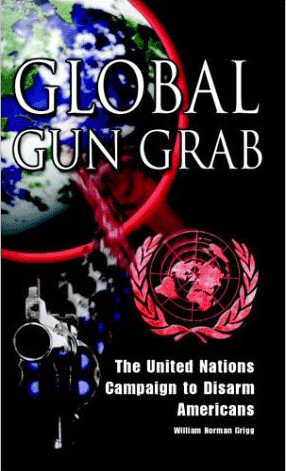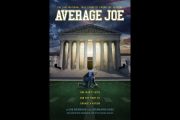
In Global Gun Grab: The United Nations Campaign to Disarm Americans, William Norman Grigg exposes the UN’s worldwide campaign to eliminate civilian ownership of firearms and explains the dangers facing Americans.
William Norman Grigg, a senior editor of The New American, has covered numerous United Nations events, including the 1994 population summit in Cairo, the 1995 social development summit in Copenhagen, the 2000 Millennium Forum at UN headquarters in New York City, and the 2001 small arms conference, also at UN headquarters. Like many who have toured the UN, he has seen firsthand the statue of a Colt Python revolver (a civilian weapon), its barrel twisted into a knot, in a courtyard in front of the UN building. He has also seen the UN’s “Meditation Room” and the pagan imagery near its entrance, which symbolize the UN’s contempt for traditional Judeo-Christian morality every bit as much as the anti-gun statue symbolizes its antipathy for civilian-owned firearms.
Grigg has spent many hours listening to speakers and panelists at UN meetings, where the would-be architects of world government are generally much more explicit in venting their authoritarian designs than they are when they address the “unwashed.” He has also spent countless hours studying UN documents. He knows that the UN is not, and was never intended to be, a mere forum for debate. It is instead, and was always intended to be, part of the framework for an eventual world government.
Grigg is not only a capable researcher but an accomplished writer and thinker. Regular readers of The New American are well acquainted with his powerful prose, having read innumerable articles by him in the pages of this magazine. They are also familiar with his mastery of a range of issues, including the UN.
But more and more, it is becoming impossible to address other important issues — from federal land grabs to abortion — without taking into account the intended transfer of power from the U.S. to the UN. In 1995 Grigg wrote his blockbuster book Freedom on the Altar, which exposed the UN’s war against God and family. In his just-released book, the subject of this review, he explains that “in matters of disarmament, all roads lead to the UN.”
In Global Gun Grab, Grigg reveals the real intent behind the UN’s call for “general and complete disarmament.” That intent, he convincingly demonstrates, has much more to do with acquiring a monopoly of power than with eliminating all armaments. Whether the armament in question is a weapon of mass destruction or a Colt Python revolver, the UN seeks a globalized police apparatus that will enable it to impose its will on all the nations and peoples of the Earth. That apparatus will control the world’s armaments. And those armaments, Grigg persuasively argues, will be used, not to enforce world peace, but to impose world tyranny.
Grigg also shows how the UN game plan has been unfolding, not only in faraway lands where civilian populations have been disarmed, but even here in the United States of America.
From Rwanda to America
Grigg’s small book is tightly written and fast-paced. The reader is whisked from the killing fields of Rwanda to Hometown, U.S.A. It is therefore impossible, in a short review, to provide the reader with a comprehensive summary. A few examples will have to suffice.
To put the UN threat in its proper perspective, Grigg shows how the UN, rather than usurping power directly, is instead the beneficiary of power that is being transferred to it by globalist insiders. He notes the role of the Council on Foreign Relations, the ubiquitous private organization that has long dominated our foreign policy establishment. He also discusses Freedom From War: The United States Program for General and complete Disarmament in a Peaceful World, the State Department document that President John E Kennedy submitted to the UN in September 1961.
Grigg recalls that in “the third stage of the Freedom From War plan, ‘States would retain only those forces, non-nuclear armaments, and establishments required for the purpose of maintaining internal order; they would also support and provide agreed manpower for a UN Peace Force.’ Stage III further provided that the ‘manufacture of armaments would be prohibited except for those of agreed types and quantities to be used by the U.N. Peace Force and those required to maintain internal order. All other armaments would be destroyed or converted to peaceful purposes.’ ” The Freedom From War scenario, Grigg points out, remains to this day “the official framework for U.S. arms control policy.”
That policy is frightening in light of the historical record of oppression by tyrannical governments of disarmed populations. Political scientist R. J. Rummel, who coined the term “democide” to describe the systematic murder by governments of their subject populations, calculates that at least 170 million human beings were killed by their governments during the 20th century, making (in Grigg’s words) “the unrestrained, lawless state in all of its manifestations” the “single largest source … of lethal violence.” Indeed, “mass murder is the only field of endeavor in which the state outperforms its private sector competition.”
Of course, the danger of gun confiscation leading to mass murder exists even if the initial gun restrictions are put in place by sincere liberals who are attempting (however foolishly) to reduce crime. In Hitler’s Germany, for example, the gun laws that “proved so useful to the Nazi regime were enacted by its predecessor, the liberal Weimar Republic.” “Once a population has been disarmed by a relatively humane government,” Grigg warns, “it is deprived of the most valuable means of resisting the rise of a more corrupt ruling elite.”
He also explains why “tyrants who seek to disarm their would-be subjects physically must first disarm them psychologically.” So-called gun “buy-back” (or “turn-in”) programs, which entice peaceful citizens to surrender firearms in exchange for cash or other enticements, are part of the psychological ploy. A key objective is to “demonize guns as intrinsically evil,” thereby “preparing the public for more aggressive civilian disarmament measures.”
Another aspect of psychological disarmament is the outlandish “zero tolerance” school policy that seeks to “indoctrinate children in the belief that guns and other weapons are such evil objects that they can’t be touched, seen, spoken of, alluded to, or even thought of by students, upon penalty of expulsion and incarceration.” Grigg cites numerous examples, including instances of suspension or other punishment for drawing pictures of guns, playing “cops and robbers,” and possessing tiny replicas of firearms.
In a chapter devoted to the 1994 genocide in Rwanda, Grigg details the role played by Kofi Annan, who was then chief of UN peacekeeping operations. At least 800,000 Tutsis were slaughtered by the Hutu-dominated government and its killing squads. On one occasion, Canadian Lt. General Romeo Dallaire, commander of UN military forces deployed to Rwanda in 1993 to administer a cease-fire, sought permission to raid a government weapons cache. He had been briefed by a defector from the Hutu regime, who also warned that the government planned to register all Tutsis in the capital of Kigali, possibly to pave the way for their extermination. Incredibly, Grigg writes, General Dallaire was not only forbidden “to disarm the government killing squads,” but ordered “to share his information with the Hutu government.” The fax order, it was determined later, was authored by Annan.
The Rwandan genocide occurred in large part because the “civilian population was disarmed, except for militia units under central government control.” The UN peace accord had “called for efforts to confiscate ‘all weapons distributed to or illegally acquired by civilians,”‘ but before the killing began “the Hutu-dominated government had distributed automatic rifles and hand grenades to official militias and paramilitary gangs. It was this firepower that made the genocide possible.”
Grigg also describes UN “peacekeeping” campaigns in Croatia and Somalia, concluding that from those actions “we can piece together the UN’s civilian disarmament ‘escalation ladder’: First comes the psychological disarmament campaign to persuade civilians to turn in their guns; then comes a show of force to intimidate them into giving up their weapons. Typically, it is only after these efforts fail that lethal military force … would be used.”
Grigg contends that those Americans “who expect an apocalyptic invasion by blue-helmeted UN troops are fixating on the wrong threat. A much more plausible scenario is that UN civilian disarmament policies would be enforced by Americans against Amen cans.” The main threat posed by the UN “is not invasion, but subversion,” and in the foreseeable future “the chief impact that the UN will have upon American institutions and policies will come in the form of ‘harmonization’ — meaning that our laws and governmental policies will be adjusted to conform with our nation’s supposed ‘international obligation’ as defined in UN treaties and conventions.” The most serious threat we face “comes not from the UN itself but from American institutions that are being corrupted and placed at the service of the UN’s agenda — particularly the U.S. military and our law enforcement agencies.”
Call to Action
In the final chapter of his captivating overview of the UN gun grab, Grigg argues that the goal of gun owners and the American people as a whole must be to get the U.S. out of the UN in order to remove the UN threat. Reform is not the answer.
Noting the “active and growing constituency for American withdrawal from the world body,” Grigg reminds his readers of the tireless work of the John Birch Society “to educate and mobilize the American people at the grass-roots level.” The Society, he states, “devotes its efforts to the strategy employed by the Founding Fathers in the decades leading up to American independence: educating the citizenry in sound principles of government; warning the public about the existence of an organized, covert threat to our liberties and free institutions; and mobilizing patriots in an organized, principle-centered effort to defeat the enemies of freedom.”
In short, Grigg’s book is not just a compact digest of vital information, it is also a call to action. This reviewer could not recommend it more highly.



